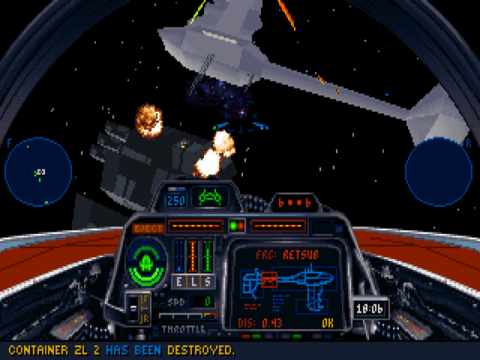
X-Wing
Written by: Rik
Date posted: November 11, 2022
- Genre: Simulation
- Developed by: Lucasarts
- Published by: Lucasarts
- Year released: 1993
- Our score: 8
X-Wing perhaps represents the largest disconnect between extremely strong nostalgic memories of a game and the reality of my actual experience at the time. It was the cover star of the very first issue of the UK’s greatest ever PC gaming magazine, solidifying its reputation in my mind as one of the first ‘must have’ games for the system – something that the Amiga and consoles couldn’t handle. And then there was the animated introduction sequence, expertly tuned to maximise excited anticipation of the game ahead: “Excellent! Prepare the attack…”
Even now, those memories and feelings all feel so vivid. Even the bit on the menu when you forget to put your pilot name in and get told “You must register!” by a guard pointing a gun towards the screen takes me right back. I remember it! I was there! What a great game! It would be so easy just to tell myself I experienced this game to its full extent and leave it at that. I do remember it, I did play it, and I completed games like it: 90s space combat rivals like Wing Commander 3, and even X-Wing‘s own sequel, TIE Fighter.
Tempting as it is, though, and as has been well documented elsewhere on this site, X-Wing was a game at which I failed miserably, very early on, and was abandoned as a lost cause many years ago. Since then, it’s lingered in the Vault of Regret, along with any realistic hopes of ever playing it, or any other vaguely serious simulation type game, again.
Except I wasn’t having that, readers! Yes, I felt vindicated by general acknowledgement over the years that X-Wing was a tough, sometimes unfair, game. And yes, I’ve come to accept that sometimes things just aren’t meant to be, and that my extremely slow quest to comb through and write about the games of my past will be marginally more successful if I don’t expend time and energy on things that make my head hurt. But surely, X-Wing wasn’t beyond me, if I really put my mind to it? And it wasn’t, as it turns out: I have now completed X-Wing. Stand by for a summary of thoughts from a man in 2022 about a game from 1993. (Hey, it’s what we do).
Based on arguably the best bits from the original Star Wars films, X-Wing tells a longer version of the story of the destruction of the first Death Star through the eyes of a pilot who, unlike Luke Skywalker, does not just saddle up for the final glory mission, and instead has to earn that moment by chewing through several hours of supplementary action across three campaigns and 38 missions. (Caveat time: there are more missions, including extensive training, but to be frank I was keen to dive straight into the main action and work it out from there. Plus, there are two mission disks – Imperial Pursuit and B-Wing – that are included in the commercially available digital releases, and I didn’t play either of them. Look, a man has his limits).
With a choice of three versions to play – the 1993 original, a 1994 special edition which uses the TIE Fighter engine (adding Gourad shading), and a further 1998 release based on X-Wing vs. TIE Fighter which upped the resolution and featured texture mapped graphics – I opted for the middle one, for reasons I can’t quite explain. Clearly I wanted that mid-90s experience but not to the extent that I wanted to play the original version that I actually had back in the mid-90s. I imagine that the 1998 edition will be most people’s preferred choice, although it does replace the iMUSE MIDI music system, in which the music reacts in real time to in-game events, with higher quality but completely linear CD audio. The 1994 effort feels like more like the original but with slightly better graphics and sundry other tweaks, such as extra voice acting, including the vocal contributions of Erik Bauersfeld as Admiral Ackbar.
Despite the extra bells and whistles, and that memorable intro, X-Wing is of the 90s LucasArts tradition of using animated story scenes extremely sparingly, to the extent that you soon get used to the fact that you’re not going to see one every mission or even every couple of missions, only to be surprised on occasion by a 15 second clip of something happening. The sequences you’re likely to see most often are of your pilot’s rescue and rehabilitation, his interrogation by the Imperials, or his funeral, depending on the mission and the circumstances of its failure.
Because, as we mentioned, X-Wing is quite hard, and flies in the face of convention by not even saving its hard bits for the end. One memory I do have of my abortive attempts to play this game at the time is of a keenness not to be captured or killed because although your progress is saved, you lose your high score and any medals. I think for a while I even resorted to backing up the save and restoring it until I realised I was probably never going to finish the game under any circumstances. Even now, the idea of someone getting through X-Wing without once dying or being captured seems like some kind of sick joke, as it was rarer for me to actually make it through a mission on the first try. To be fair, you can always cut your losses and hyperspace out if your situation seems hopeless (and you haven’t sustained damage to your hyperdrive), although that’s not tempting when you’ve battled through a lot of shit already and don’t want to have to do it all again.
Your own experience may of course vary, especially if you’re better at games than me. And the three campaigns (known as Tours of Duty) are supposed to follow the training programme and simulated ‘historical’ missions in terms of difficulty and learning curve, but I got bored of doing all of that ‘learn to identify containers’ stuff back in the 90s and I just went all in on the first Tour straight away. Perhaps that was an error, although I think that while some of the key skills and principles required might have been a bit sharper in my mind, I don’t think it would have made that much of a difference to my speed of progress. (I must also admit that I did my flying and shooting with an Xbox 360 pad, which was the most palatable option available to me without splashing out on an actual joystick, but probably wasn’t ideal).
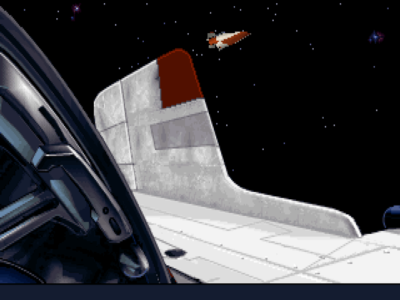
There are multiple camera angles to choose from; any straying from the default on my part was a case of accidentally hitting the wrong key.
One thing that you absolutely have to take on board is the management of your ship’s energy systems: adjusting the power allocated to the engine and the recharge rates of your lasers and shields as required, and diverting stored power from lasers to shields and vice-versa at short notice. This is not a case of making things easier for yourself with clever occasional switches or giving you options to approach situations in different ways depending on your preferences, and more one of realising that constant monitoring and adjustment of these systems is as fundamental a part of the game as all the flying around and shooting.
It’s not that difficult to get your head around, and soon becomes second nature, but until you realise that proactive hammering of these settings is key to survival, you’re most likely going to be left scratching your head and baffled by constant death and failure. Equally, the X-Wing is only one of three Rebel Alliance ships featured in the main campaign, with some missions putting you on the more nimble A-Wing and others in the Volvo of the skies, the Y-Wing, and you’ll have to get used to their strengths and weaknesses too.
Paying attention to the briefing and your role in the mission is also key. It sounds obvious, but unlike, say, the Wing Commander games, which tended to featured quite a few generic ‘fly a patrol around various waypoints’ missions peppered with dogfights, X-Wing is rather more prescriptive, warping you straight in with instructions on what the mission is and what you’re meant to be doing, which often isn’t just ‘try and destroy the nearest enemy TIE Fighters until they’re all gone’. If, to take the example of an early mission that floored me and led to the near-30-year hiatus between attempts at this game, you are supposed to protect a medical frigate, then you need to make sure you prioritise the TIE Bombers that represent the greatest danger.
All of which is fair enough, and the variety of missions on offer certainly keeps things interesting. On the other hand, your expected capacity for dealing with the unexpected seems unreasonable: surprise last-minute reinforcements shouldn’t be a surprise, really, but there are a number of spirit-crushing moments when they arrive just as you thought you’d cracked it and blast your mission, and your hopes and dreams, into pieces. There’s no significant radio chatter, either, so you’re reliant upon text announcements at the bottom of the HUD, some bleepy-blooping from your R2 unit, and urgent changes of MIDI music for real-time information on how the mission is going (a blast of the Imperial March is never good news). Otherwise, it’s checking the maps and briefing notes for further clues. There’s none of the scripted cinematic drama of later Wing Commander titles, and that sense of being part of a team communicating with each other and working towards an objective isn’t really there.
Such feelings are compounded by the fact that, without exception, the other pilots in the Rebel Alliance, as featured in this game, are utterly hopeless. You can issue instructions to your direct wingmen, but they’re probably all going to die anyway, so it’s usually only a question of whether any of them actually manage to take anyone or anything down before that happens. As for other squadrons, they can be equally useless, and for all that the mission briefing tells you that your job is to do X while others do Y, chances are that you’ll have to do both X and Y yourself, and usually the second bit in a craft ill-suited to the task. Be prepared for dogfighting in a Y-Wing or trying to attack a capital ship in an A-Wing. I guess the Rebels are supposed to be the underdogs, and it wouldn’t really work if your wingmen did all of the hard work instead of you, the hero, but even allowing for all that, it does feel like a struggle at times.
And yet. There’s still something magical here, and despite its primitive graphics, X-Wing still manages to conjure up that feeling of being part of one of those iconic big space battles from the movies. While at the time it may have lacked the instant audio-visual spectacle of something like Rebel Assault, and it’s true that technology restricts the number of ships on screen at once and makes things occasionally feel rather sparse, when it comes, for example, to taking down a Star Destroyer (a mission that I had to attempt roughly a million times) that sense of being one of the nervous-looking pilots from the films, about to go into battle and attempt the impossible, is certainly present and correct.
Time spent on trying to beat a mission can sometimes result in attempts getting worse rather than better, and it takes some time to adjust to the rhythms of a game in which that’s the case, where your investment of time doesn’t necessarily mean progress. But victory never seems completely out of reach, and when you get stuck it rarely feels totally hopeless, even if you probably can’t face having another go immediately and might need to sleep on it for a while. (And possibly consult the strategy guide – although even then, it’s one thing knowing what to do, and quite another actually doing it).
The final Death Star run is perhaps the mission most hobbled by the technical limitations of the era, and certainly seems a lot more ponderous than the finale of A New Hope if you elect for a prolonged and occasionally futile-seeming fight with the superior TIE Advanced craft, during which the thought occurs that the X-Wing lasers seem specifically designed not to align with the shape of a TIE Fighter as you direct fire at the great big gaps between the cockpit and wings instead. However, it still retains a great deal of power, and the tension of dodging through the final trench and getting those photon torpedoes away is matched by the sense of triumph and relief if and when you actually manage to pull it off.
(Your correspondent did contrive to go the wrong way down the trench – away from the target – at one point, as well as crashing into a pillar with really not much distance left, the sheer shock and tragedy of which cut to the core of me to such an extent that I was only able to utter a meek and feeble cry of ‘Nooooooo!’ rather than the usual effing and jeffing).
I’m not one to really geek out on Star Wars any more, but there are many moments such as this where the only appropriate response seems to be to start quoting liberally from the films – “Let’s blow this thing and go home!” (even though Han Solo’s intervention isn’t noted or referenced here); “Switch all power to front deflector screens…” (even though you can only be talking to yourself); and even “I have you now!” (a Darth Vader line, but still satisfying to say when you finally get a pesky fighter in your sights regardless).
It’s hard to rule out the possibility that this level of appeal is generational, much as I used to be baffled when older gamers claimed that the 1983 Star Wars arcade game really nailed the Death Star attack experience, when to my eyes it seemed rather primitive and unexciting. Still, speaking as someone who didn’t get on with X-Wing at the time and possibly felt that audio-visual advances of the 90s aged it prematurely, I was surprised at the extent to which it was able to involve me and stir up Star Wars related feelings again. (The MIDI score, for example, is deployed so effectively that you never even consider turning it off, at which point you would surely notice the fact that there are no engine sounds, nor very many other sound effects at all).
And all of that without any of the cinematic razzmatazz of Wing Commander 3 and 4, which more easily held my attention at the time. Instead, you can have Mon Mothma giving you a medal, or brief glimpses of Princess Leia, Darth Vader or Grand Moff Tarkin every few hours or so. There are no branching mission trees either: do, or do not – there is no try. This is Star Wars after all.
I can’t pretend that others might not find X-Wing unfair and off-putting. Certainly, there were times where I felt that I couldn’t quite muster the energy to tackle a really difficult mission again, no matter how close I felt I was getting, or how much determination was bubbling under the surface. If you’re used to the kind of game where putting a couple of hours in of an evening moves you forward, even only slightly, then getting nothing but failure and a headache for your endeavours is a bit of a change of pace.
Still, I reckon X-Wing has still got it. For all the small moments of frustration, there are plenty of big moments of satisfaction and triumph. You get to do that thing where you blast a helpless little TIE Fighter out of the sky with a couple of well-timed shots; where you corkscrew towards the bridge of a Star Destroyer and take out its shield generators; and where you weave down that Death Star trench and make that great shot (kid) that’s one in a million. It’s a flawed great, for sure, but one that’s still worth your time.

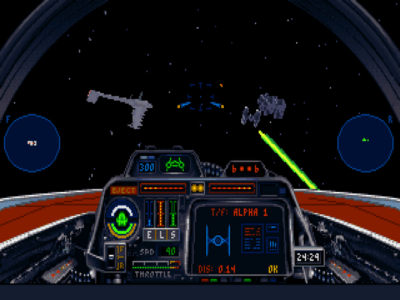
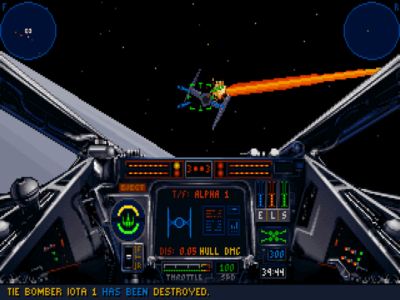
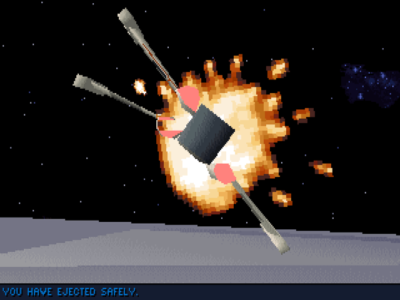
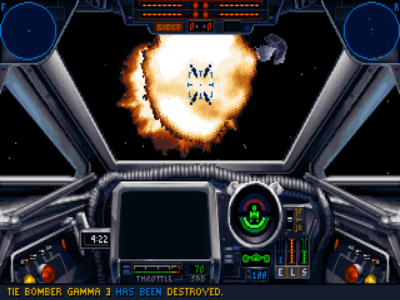
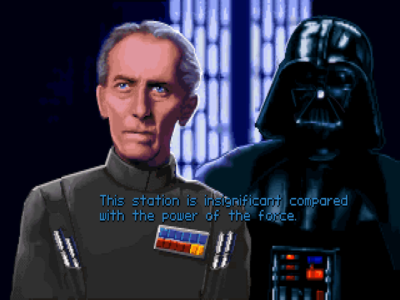

 Posts
Posts
awesome review! any chance at a similar one for TIE Fighter?
November 15, 2022 @ 1:25 am
Thanks! My colleague Stoo reviewed TIE Fighter back in this site’s very early days – it must have been among the first ever reviews we put up. (Yes, we’ve been around a while; no, we don’t cover games in a logical order…)
November 15, 2022 @ 12:39 pm
Outstanding review. Also I salute your efforts in completing the game, I gave up on the first campaign and never returned…
IMO you probably played the best version; the upgraded graphics of the 1998 version aren’t worth losing the responsive iMUSE soundtrack. I kinda the abstract look of the untextured polygons anyway.
November 17, 2022 @ 12:28 pm
The 1998 version does some awful smoothing of the animated cut scenes (including the intro), which sort of irons the charm out of them, too.
November 17, 2022 @ 6:18 pm
Nice review, and congratulations on slaying your white whale! I thought I had saved my pilot profile from college but casual searches haven’t turned anything up. Probably for the best, as I’d need to start all the way over to have a serious shot at the expansions. I also had a gamepad and got pretty good with whatever custom layout I trial and errored, but no idea what it consisted of today. Some power presets and a jump to 100% throttle, maybe.
I guess along the same lines, don’t know why I never got into HOTAS setups. Cost, sure, but I managed to find a cheap one long ago and it still never “clicked” for the games I tried. I’d think I’d be all about having an array of programmable physical buttons to flick shields to double-front, but I guess not.
December 4, 2022 @ 3:17 am
Thanks J!
I hadn’t really thought of X-Wing in ‘white whale’ terms until that casual throwaway comment a couple of months ago, but at some point it went from being on a list marked ‘never gonna happen’ to ‘perhaps… it could happen? Maybe?’
I used my Xbox 360 pad like a one button joystick – move and fire only, everything else was mapped to keyboard shortcuts! Once bought a fairly cheap stick with throttle back in the day in the belief that it would help me make progress with Privateer 2: The Darkening, which it didn’t, and then it sat around until USB arrived and computers no longer had joystick/game ports.
December 7, 2022 @ 4:55 pm